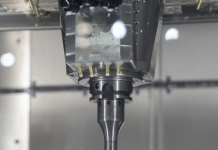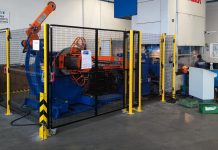Quantifying the geometrical errors allows then defining the quantitative performance parameters that can “measure” the machine tool performance and it eventually allows compensating the detected errors.
[su_slider source=”media: 585,586,587″]
In a machine tool the geometrical errors of the motion axes determine the positioning error of the tool in the machining volume. Named volumetric error in the functional point, it actually represents the relative variation between the real position of the tool referred to the workpiece and the ideal one, and it represents a critical factor for the quality of the machine and of the workpieces that it produces. Quantifying the geometrical errors allows therefore defining quantitative performance parameters that can “measure” the machine tool performance, and it eventually permits to compensate the detected ones.
General principles
Starting from the preliminary assumption that geometrical errors influence the relative motion among machine components holding the tool and components holding the workpiece, it is important to bear in mind that these errors must be measured in the position or in the path of the functional point. That’s to say the centre of the tool or that point where the tool gets in touch with the piece and that therefore can move inside the machine working volume. The ISO 230-1 directive and the other specific regulations for machine typology typically recommend determining the errors between the tool in motion, having an estimated average length, and the hypothetical centre of a piece that we assume to be localized in the centre of the stroke of the machine tool axes. When we determine the geometrical errors to make the compensations, the functional point or its trajectory must be attentively chosen taking into account the CNC configuration, the kinematic chain of the machine tool and the CNC compensation logic. Assuming the “stiff body model” as kinematic model of the machine, the angular errors of a body that linearly moves along an axis are not affected by the relative position of the other machine axes, while the positioning error and the straightness errors lead to different results depending on the localization of the functional point in the machining volume.
Measuring methods
The measuring methods of the geometrical errors of machines are defined in the regulations for their testing, to which readers should refer for the details concerning instruments, their setup and measuring procedures. Let’s examine now the 6 geometrical errors for each axis (X, Y, Z), in the case of a horizontal spindle machine with cross bed, for a total of 18 errors. It is worth reminding that today there are different measuring systems (not treated in this article), some also strongly automated with dedicated measuring software, which use very accurate laser systems and allow performing equivalent measuring with much shorter test times.
EAX and EAZd or ECX and ECZ angular error measuring of a horizontal linear axis
The measuring of the angular roll errors of the X axis and of the pitch ones of the Z axis can be carried out, with the same measuring configuration, by using electronic precision levels with the differential method. 2 levels are used, one positioned on the machine head and considered as reference level and one on the component in motion (table that moves along the X and Z axes); both are positioned to detect the rotations according to the X axis.
In case of measuring of the angular pitch errors of the X axis and of roll ones of the Z axis, the levels are positioned to detect rotations along the Z axis. We perform then the differential reading of the 2 levels by moving the mobile body along the X axis and then along the Z axis with an adequate pitch.
EAY and ECY angular error measuring of a vertical linear axis
Also the measuring of the angular pitch and yaw errors of the Y vertical axis can be carried out by electronic precision levels using the differential method. The Y axis is positioned at the extremity of the stroke and the readings of the two levels are executed by moving the body along the Y axis with pitch usually equally to 1/10 of the total stroke. The positioning of the levels on the horizontal plan will be rotated by 90° depending on whether we want to measure the pitch or yaw angle.
EXX, EYY iand EZZ positioning error measuring of linear axes
The measuring of the positioning errors of the X, Y and Z axes is carried out with a laser interferometer with linear optics. The linear interferometer is fixed on the moving component (table) and the reflector fixed to the head. The axis is positioned at the stroke beginning and the positioning errors are detected, meant as difference between the value set by the numerical c control and the value detected by the interferometer, in forward and backward stroke for 5 consecutive times; the positioning error for each measuring pitch can be calculated by the average of the detected errors. The acquisition and the processing of data occurs through the processor connected with the laser interferometer.
EYX, EZX, EXZ, and EYZ straightness error measuring of horizontal linear axes
The measuring of the straightness errors of the X axis and of the Z axis is carried out with the method of the comparator and of the control rule. It is customary to fix the control rule on the component taken as reference (the table) and the comparator in the point where the tool is positioned, with the probe in contact with the control rule. We position the mobile body at the beginning of stroke of the X or Z axis, we zero the comparator and we align the control rule in order to have the same reading of the comparator at the stroke beginning and end; we execute then the readings of the comparator by moving the body along the X or Z axis with adequate pitch; once reached the stroke end, we go back until the initial point. The straightness error is given by the average of the 2 readings of the comparator for each pitch.
EBX and EBZ angular error measuring of horizontal linear axes
The measuring of the angular yaw error for the X axis and for the Z axis is performed by a laser interferometer with angular optics. The angular interferometer is fixed on the component in motion (table) and the reflector is fixed on the head. The axis is positioned at the stroke beginning and we detect and the angular forward and backward errors for 2 consecutive times; the angular error for each measuring pitch is given by the average of the 4 angular errors detected. The data acquisition and processing occurs by means of the processor connected with the laser interferometer.
EXY, EZY straightness error measuring of a vertical linear axis
The measuring of the straightness errors of the Y vertical axis in the XY plane and in the ZY plane is performed with the method of square and comparator. In the first case we position the square on the table in the XY plane (or in the ZY plane) so that the vertical face is parallel to the head motion (Y axis); parallel means that the reading of the comparator at the square extremity must be the same. The comparator is mounted by means of an apposite support on the machine head. We position then the head at the beginning of the Y axis stroke, we zero the comparator and we carry out the comparator readings by moving the body along the Y axis with pitch usually equal to 1/10 of the total stroke; once arrived at the stroke end, we go back until the initial point. The straightness error is given by the range (difference between the maximum and minimum value) of all readings.
EBY angular error measuring of a vertical linear axis
The measuring of the angular roll error of the Y vertical axis is executed by using a square, a comparator and a level. It is necessary to position the square on the table in the ZY plane so that the vertical face is parallel (comparator readings equal to the square extremities) to the head motion (Y axis); the comparator is mounted by means of an apposite support on the machine head. We place the square in 2 positions typically at a distance of 600 mm; in the first position we zero the comparator at the beginning of the Y axis stroke and we perform the comparator readings by moving the Y axis with definite pitch in forward and backward stroke, then calculating the arithmetic mean. We move then the square to the other position and we repeat the measuring. In order to compensate the possible angular error of the table, an electronic level is placed on the table and, through the value read by the level, we correct the reading data (by multiplying the detected angle by the height of the measuring point from the table). The angular roll error of the Y axis, for each measuring pitch, is calculated (expressed in radiants) as ratio between the difference of the mean readings (mean between forward and backward) on the two positions of the square (compensated through the value of the level on the table) and the distance between the 2 positions themselves.
Conclusions
Even reaffirming that there are several methods for measuring the geometrical errors of a machine tool, we can state that their quantitative determination, even partial (that’s to say of some errors only, the main ones), periodically repeated during the machine tool operation, is essential. This to keep under control the machining precision of the machine itself and to evaluate the opportunity of executing suitable compensations according to the methodologies suggested by the manufacturer.



